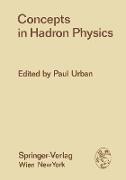Concepts in Hadron Physics
BücherAngebote / Angebote:
Soluble quantum field theory models are a rare commodity. An infinite number of degrees of freedom and noncompact invariance groups have a nasty habit of ex ploding in the model-makers' face. Nevertheless, impor tant progress has recently been made in the class of superrenormalizable relativistic theories, such as a self-interacting boson in a two-dimensional space time [ 1]. These results have been obtained starting with the free field and adding the interaction in a carefully controlled way. Yet, the models successfully studied in this way do DQ~ have an infinite field strength renormalization, which, at least according to perturbation theory, should appear for realistic relativistic models in four-dimensional space time. ~2~!Y~~!9n_~g_~h~_~gg~1 The ultralocal scalar field theories discussed in these lecture notes are likewise motivated by relativistic theories but are based on a different approximatiGn. This approximation formally amounts to dropping the spatial gradient term from the Hamiltonian rather than the non linear interaction. For a self-interacting boson field in a space-time of (s+l) dimensions (s~l), the classical ultralocal model Hamiltonian reads (1-1) The quantum theory of this model is the subject of the present paper. This model differs formally from a rela tivistic theory by the term f![Z~Cl(~)]2 d~ which, it is hoped, can, in one or another way, be added as a pertur 229 bation in the quantum theory. However, that still remains a problem for the future, and we confine our remarks to . . a careful study of the "unperturbed" model (1-1).
Folgt in ca. 5 Arbeitstagen
